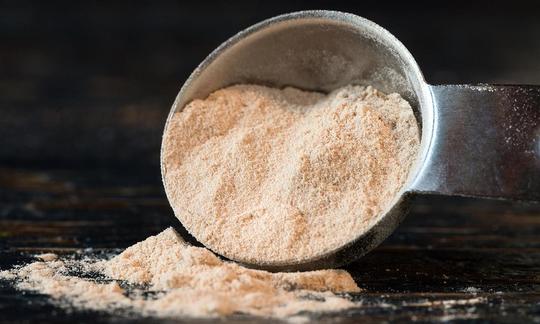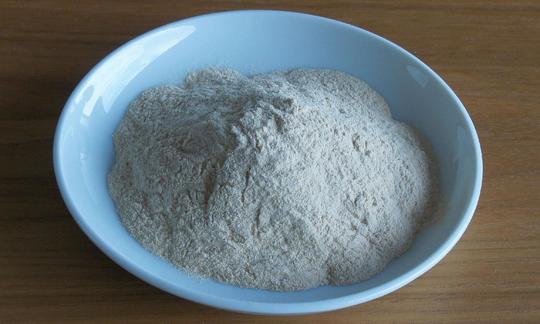Table of contents
Lucuma powder is mainly used as a sugar substitute and consists of ground lucuma fruit ( Pouteria lucuma). It tastes sweet, but the calorie and carbohydrate content is lower than that of sugar. The powder flavors and sweetens ice cream, puddings, muesli and pastries. Organic quality?
Use in the kitchen
What is Lucuma powder? Lucuma powder is made by gently drying and then pulverizing the fresh, yellowish flesh of the South American Lucuma. The nutrient-rich powder has a unique taste that is described as sweet, caramel-like and creamy. Lucuma fruits are said to taste like a combination of sweet potato, maple syrup, vanilla pods and caramel candy, or to be reminiscent of a fruity mixture between mango and apricot. The powder has a nutty and citrus note.
Due to its sweet aroma, Lucuma powder is used as a sweetener or sugar substitute. To reduce the amount of refined granulated sugar, replace it with Lucuma powder in a ratio of 2:1: instead of 1 tablespoon of granulated sugar, you can use 2 tablespoons of the powder. Although you need a larger amount, the amount of sugar used is lower.
Lucuma powder is ideal for sweetening desserts, pastries, puddings and drinks, as well as smoothies made from fresh fruit and vegetables such as bananas, strawberries,raspberries, mangos, kiwis, cucumber and celery. Porridge with linseed or oat flakes, such as poppy seed and lemon porridge, yogurt ( soy yogurt) and muesli can also be rounded off with lucuma powder. For a healthy breakfast option, we recommend Erb-Müsli.
Lucuma powder is used primarily in ice creams. In Peru and Chile, lucuma is one of the most popular ice cream flavors in the country, surpassing even the traditional flavors of vanilla and chocolate. Lucuma powder is also ideal for adding an aromatic note to organic nut butter. Add a tablespoon of the powder to your favorite nut butter made from almonds, walnuts, pistachios or hazelnuts to refine it with a subtle caramel sweetness. Nut butter is also easy to make at home. You can find out more about making it yourself under the ingredient almond butter or peanut butter.
Lucuma powder can be added to a wide variety of dishes due to its good solubility and emulsifying properties. Lucuma powder can also be combined with savory dishes. It can be added to spicy sauces and marinades to add a touch of exotic sweetness.
Vegan recipe for smoothie with lucuma powder
Ingredients: 2 tbsp lucuma powder, 1 banana (organic), 100 g soy yoghurt, 150 g strawberries (fresh/frozen, organic), 100 gblueberries (fresh/frozen, organic), 1 tsp almond butter (dark).
Preparation: Remove the peel of the banana and put it in a blender together with the strawberries, blueberries and soy yoghurt and puree. Then add the almond paste and the lucuma powder and mix well again. Depending on the desired consistency, add a little water or almond milk. For a sweeter version, add 1 tbsp agave syrup or maple syrup. Pour into a glass and enjoy the vegan smoothie. Optionally decorate with chia seeds, cocoa beans (cocoa nibs) and peppermint.
Vegan recipes with lucuma powder can be found under the note: " Recipes that have the most of this ingredient ".
| Not only vegans or vegetarians should read this: Vegans often eat unhealthily. Avoidable nutritional errors. |
Purchasing - Storage
Lucuma powder can occasionally be found in well-stocked supermarket branches such as Coop, Migros, Denner, Volg, Spar, Aldi, Lidl, Rewe, Edeka, Hofer, Billa and Kaufland. In any case, the fruit powder can be bought in organic supermarkets, including Denn's Biomarkt and Alnatura, as well as health food stores and health food stores. It is usually found in the food supplements section. Lucuma powder is also available online.
When buying, pay attention to organic quality and the purity of the product. Lucuma powder should consist of pure, ground lucuma pulp and be free of additional fillers, artificial flavors, colors, preservatives and sweeteners.
Lucuma powder is available in raw food quality. However, this requires that the fruit has undergone a gentle drying process. Hot air tunnels are often used in which temperatures of 60 °C are reached. 9 If the Lucuma fruit is dried at such high temperatures, then it and the powder produced from it are no longer considered raw! When buying, consider raw food quality. However, it should be noted that it is difficult to verify whether the Lucuma powder you buy is really raw food quality. The term raw food is not subject to any controls and is associated with a great deal of trust in the producers.
The availability of Lucuma powder varies depending on the size of the store, catchment area, etc. Our recorded food prices for the DA-CH countries can be found above under the ingredient image - and by clicking on them you can see their development at various suppliers.
Storage tips
To ensure an optimal shelf life of several months, it is recommended to store the Lucuma powder in dark and dry conditions and at room temperature. Well-sealed containers, such as a screw-top jar or a tightly sealable tin that allows airtight storage, are ideal.
Ingredients - Nutritional values - Calories
The energy content of 100 g of unsweetened Lucuma powder is 372 kcal. These calories come mainly from carbohydrates (87 g/100g), of which 15 g are sugar. The calorie and carbohydrate content is therefore lower than that of sugar. Lucuma powder is relatively low in protein and fat with 1.4 g of protein and 2.4 g of fat per 100 g. Dietary fiber is present at 2.3 g/100g.
With 50 mg/100g, Lucuma powder is rich in vitamin C (ascorbic acid) (corresponds to 62% of the daily requirement). A comparable amount of the vitamin is found in strawberries (59 mg/100g) and cauliflower (48 mg/100g). Yellow bell peppers with 184 mg/100g and sea buckthorn berries with 450 mg/100g have particularly high amounts. Guava contains more than four times as much vitamin C, with 228 mg per 100g.
Lucuma powder contains 4.6 mg of iron, which makes up 33% of the daily requirement. Oatmeal has similar values at 4.2 mg/100g and dried peaches at 4.1 mg/100g. Foods that contain significantly more iron include raw morels (12 mg), white beans (10 mg), dried tomatoes (9.1 mg) and dried porcini mushrooms (8.4 mg). 1
Since Lucuma powder is usually only used in small quantities (tablespoon), its contribution to nutritional supply is small compared to other foods.
Lucuma powder is rich in a variety of phytochemicals, particularly phenolic compounds such as flavonoids, polyphenols and phenolic acids. Studies have shown that fresh lucuma has a remarkably high total phenol content of about 51.1 mg GAE/kg, which may even exceed that of strawberries (34.7 mg GAE/kg),blueberries (14.3 mg GAE/kg) and other fruits. The powder also has high levels of carotenoids, phytosterols and tocopherols. It also contains organic acids, including tartaric acid, quinic acid, malic acid and ascorbic acid. The variety of varieties and the different stages of ripeness affect the concentrations of these compounds in lucuma. 2,11
The complete ingredients of Lucuma powder, the coverage of the daily requirement and comparison values with other ingredients can be found in our nutrient tables. In the article Nutrients explained you will get a detailed insight into the topic.
Health effects
Is Lucuma powder healthy? The term superfood is often used in connection with Lucuma powder. However, this term is primarily used for marketing purposes. Although Lucuma powder contains a large number of secondary plant substances 2, there is a lack of comprehensive scientific evidence from clinical studies to support the advertised health benefits.
Lucuma powder may help treat high blood pressure (hypertension), as an in vitro study suggests. The fruit's antihypertensive properties are expressed by inhibiting the angiotensin-converting enzyme (ACE). ACE is involved in the regulation of blood pressure. Inhibiting the enzyme leads to vasodilation (widening of the blood vessels) and, as a result, to a reduction in blood pressure. 3
Studies also attribute antihyperglycemic (blood sugar lowering) properties to Lucuma powder. It inhibits both alpha-amylase and alpha-glucosidase. Both enzymes play an important role in the digestion of carbohydrates. By inhibiting the enzymes, the absorption of sugar in the digestive tract is slowed. As a result, Lucuma powder helps control blood sugar levels, which is important for the treatment of type 2 diabetes. 3
Lucuma powder also exhibits antioxidant activity. Both the fresh fruit and the powder were analyzed. Although the Lucuma powder had a lower phenol content in comparison, the aqueous extracts of both products showed similar antioxidant activities. This suggests that the specific type of phenolic compound may be more important for the antioxidant effect than the total amount of phenols. 3
Studies show that lucuma fruit extract has potential anti-cancer properties, particularly against breast cancer cells such as MCF-7. In vitro results indicate that lucuma exerts a dose-dependent cytotoxic effect and induces apoptosis in breast cancer cells. It also confirms that lucuma extract can disrupt the cell cycle. Supported by the rich phytochemical composition of the fruit, the study results indicate that lucuma may be a potential agent for fighting breast cancer. However, comprehensive in vivo studies and clinical trials are essential to fully understand its therapeutic potential and applicability in a clinical setting. 4
Dangers - Intolerances - Side effects
So far, no significant dangers or intolerances have been identified in connection with the consumption of Lucuma powder. It should be noted that there are hardly any scientific studies on risks, interactions, allergenic potential and consumption by pregnant women and children. Therefore, consult a doctor before using Lucuma powder and follow the consumption recommendations given by the manufacturer.
Folk medicine - naturopathy
In Peruvian folk medicine, Lucuma is traditionally used for skin problems, acne, anemia and fatigue.
Ecological Footprint - Animal Welfare
The ecological footprint of a food depends on various factors. The type of agricultural production (conventional vs. organic), average or seasonal or regional production, domestic production or import by truck, ship or plane, different types of packaging and whether the goods are fresh or frozen play a decisive role. 5
The Carboncloud website gives the ecological CO 2 footprint of Peruvian Lucuma powder as 2.8 kg CO 2 eq/kg. 6 For comparison: Carboncloud puts the footprint of banana powder from Ecuador at 2.47 kg CO 2 eq/kg. 7 Despite extensive research, we were unable to find any information for Lucuma powder from other sources. The ecological footprint should therefore be viewed with caution, as we do not have any comparative values.
Despite extensive research, we were unable to find any significant figures on the water footprint of Lucuma powder.
Detailed explanations of various sustainability indicators (such as ecological footprint, CO2 footprint, water footprint) can be found here.
The drying process used is a factor in the carbon footprint of Lucuma powder. There are processes that use fossil fuels as an energy source, which, in addition to increasing the carbon footprint, also contributes to greenhouse gas emissions. 8
Worldwide occurrence - cultivation
The lucuma fruit originally comes from the Andean highlands of Peru, Ecuador and Chile. 9,10 Lucuma fruits also grow in Costa Rica, Mexico and Hawaii, where they have little importance and significance and are relatively unknown. Attempts to introduce the lucuma tree to the USA failed due to its sensitivity to frost and were unsuccessful. 9
Peru is the leading producer of lucuma, accounting for 88% of global production. Chile is second with 12%. Peru exports the fruit mainly to Chile, followed by the United States and Canada. 9 Several industrialized countries, including Japan, China, Russia, the Netherlands, Germany and England, have joined the growing demand for lucuma imports and source the fruit from Peru. 11
Cultivation - Harvest
The Lucuma tree is not a tropical plant, but grows in dry locations at moderate altitudes of 1000 to 2400 meters, and in rare cases up to 3000 meters. Therefore, the Lucuma is classified as a subtropical species. 9,12
It is an evergreen tree that reaches a height of 8 to 15 m and has a dense crown of branches. Its branches produce a white milky sap that is characteristic of the lucuma tree. 9
A common method for propagating Lucuma trees is grafting. This involves grafting scions (shoots from selected fruit-bearing trees) onto young tree seedlings (seedling stocks). The seedling stocks serve as the root system for the grafted scions. However, this method can lead to a high degree of variability in production, as the characteristics of the tree depend heavily on the scions used. Alternatively, Lucuma trees can also be propagated using leaf cuttings, which enables more uniform production. 9
The lucuma tree has a long juvenile stage of up to 15 years, which means that it takes a relatively long time to reach its full size. 9 The lucuma fruit is round to oval and tapers to a point at the end. It has a size of 7.5-10 cm, making it about the size of a mango. 9,12 Its skin changes from green to yellow as it ripens and is relatively tender and sensitive. This makes the fresh fruit easily susceptible to damage, which makes it difficult to transport. 9
Inside, the Lucama is orange-yellow in color. The texture of the flesh depends on the variety. In Peru, there are two types of Lucuma: "Seda" and "Palo". Seda has a soft, floury texture when ripe and is suitable for consumption as a fruit. The flesh of Palo, on the other hand, is hard and unsuitable for fresh consumption. Palo is mainly used for industrial processing. 12
Lucuma is a climacteric fruit, which means that it continues to ripen after harvest. The fruits often contain 2 seeds, but 1-5 are also possible. Lucuma seeds are oval and dark brown, shiny and have a white navel spot. They are reminiscent of the pit of an avocado or a chestnut. 9
Lucuma trees begin to bear fruit after four or five years and provide fresh harvests all year round. Ten-year-old trees can produce 200-300 fruits per year. 9
Further information
The Lucuma ( Pouteria lucuma) is a plant species of the genus Pouteria, which is subordinate to the family Sapotaceae. 10
Alternative names
In Peru, the Lucuma is known as the "golden fruit" and "gold of the Incas". The subtropical stone fruit used to have the Latin name Lucuma obovata. It is also known by the names lucma, lucmo, lúcuma, lúcumo, mammon, cumala, rucma or marco. 9
Other applications
The inedible seeds of the Lucuma fruit contain a large number of polyunsaturated fatty acids. In the cosmetics industry, they are therefore of relevance with regard to skin regeneration. 10
Bibliography - 12 Sources (Link to the evidence)
| 1. | USDA (United States Department of Agriculture). Nährwerttabellen. |
| 2. | Fuentealba C, Gálvez L et al. Characterization of main primary and secondary metabolites and in vitro antioxidant and antihyperglycemic properties in the mesocarp of three biotypes of Pouteria lucuma. Food Chemistry. 2016;190:403–411. |
| 3. | Pinto MDS, Ranilla LG et al. Evaluation of Antihyperglycemia and Antihypertension Potential of Native Peruvian Fruits Using In Vitro Models. Journal of Medicinal Food. 2009;12(2):278–291. |
| 4. | Akhilesh V, Anupriya S. Potential Breast Cancer Treatment with Pouteria lucuma Fruit Extract. International Journal of Pharmaceutical Science. 2023;2(12):19-32. |
| 5. | Reinhardt G, Gärtner S, Wagner T. Ökologische Fussabdrücke von Lebensmitteln und Gerichten in Deutschland. IFEU Institut für Energie - und Umweltforschung Heidelberg. 2020. |
| 6. | Carboncloud. Lucuma fruit powder. 2024 |
| 7. | Carboncloud. Banana powder. 2024. |
| 8. | Asmat-Campos D, Carreño-Ortega A, Paço TA. Closed flow solar dehydration with the use of silver nanoparticles: Application for the production of Pouteria lucuma flour. Drying Technology. 2022;40(14):3036–3048. |
| 9. | Yahia EM, Guttierrez-Orozco F. Chapter 18 - Lucuma (Pouteria lucuma (Ruiz and Pav.) Kuntze). In: Yahia EM (ed.) Postharvest Biology and Technology of Tropical and Subtropical Fruits. Woodhead Publishing; 2011. S. 443–449, 450e. |
| 10. | Campos D, Chirinos R et al. Bioactive Potential of Andean Fruits, Seeds, and Tubers. Advances in Food and Nutrition Research. 2018;84:287–343. |
| 11. | Maza-De La Quintana R, Paucar-Menacho L. Lucuma (Pouteria lucuma): Composition, bioactive components, antioxidant activity, uses and beneficial properties for health. Sci agropecu. 2020;11(1):135–142. |
| 12. | García-Ríos D, Aguilar-Galvez A et al. Relevant physicochemical properties and metabolites with functional properties of two commercial varieties of Peruvian Pouteria lucuma. Journal of Food Processing and Preservation. 2020;44(6):e14479. |











Comments